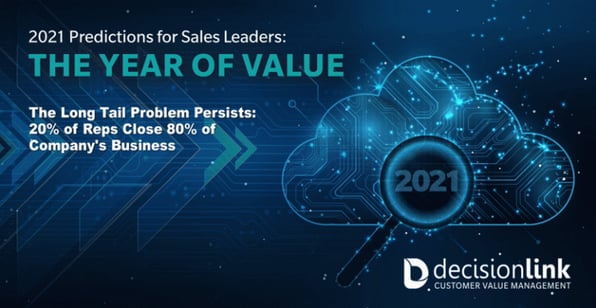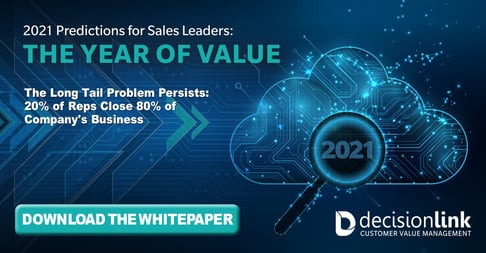The 80/20 Rule in Sales Persists

Those of us who have been researching, advising on, managing B2B sales for many years know this statistic almost as a constant – the 80/20 rule. The rule quite simply states:
20% of the sales team brings in 80% of the company’s business, the rest will struggle to meet their quotas.
In a recent study, Dimensional Research asked 200+ SaaS Sales leaders about the performance of their organization, 78% of the leaders said that at least half of their sales teams will not achieve their quota.
THE MISSING CONNECTION
What is the key skill differentiation between these top performers and the underachievers, you ask?
Well, a common answer in the same Dimensional Research study was that reps who are failing often lack an understanding of the customer’s strategic goals. This could be due to lack of training or preparation, the sheer volume of calls to different accounts required of the seller, or even a lack of general business knowledge or experience. But the outcome of this shortfall is serious. If a salesperson cannot connect the value their company delivers to their buyer’s initiatives and priorities, then the buyer is not encouraged to make a decision.
The result? Either the next seller who does bridge this gap will win the project, or the project will itself die as business initiative. Remember, most deals are not lost to the competition, they are lost to companies who chose to “do nothing”.
So, what is this connection? It is about a seller being able to discuss the concept of value (i.e. convincing a buyer – in THEIR metrics – that it is worthwhile) to proceed the planned investment. Buyers always have financial metrics to report and most business purchase decisions are supported by some sort of financial analysis and forecast, using financial instruments such as: Return-on-Investment (ROI); Total Cost of Ownership (TCO); Internal Rate of Return (IRR); Payback Period; and Net Present Value (NPV). But it isn’t only a numbers game. Buyers now expect to be engaged in a conversation that demonstrates empathy, focuses on their business issues and priorities, and is not a product pitch.
This is a challenge that will expand in the future as buyers and sellers become even more accustomed to virtual interactions—where buyers will spend less time listening to sellers; and sales efforts will increasingly be led by an Inside Sales team with even more productivity pressure.
THE CONNECTION BECOMES CONTINUOUS
Some sales teams have value consulting resources to assist in calculating the economic value their products can deliver and provide those ROI/TCO/TCO/IRR/NPV numbers, but these are usually limited, labor-intensive resources and they are often dedicated to the most strategic sales cycles – ironically, helping the 20% of the sales team excel even more. However, most of that assistance is focused on the initial investment approval as a one-off analysis.
As businesses become more accustomed to the as-a-service model and contracts are up for renewal every year, companies are beginning to expect this level of analysis to be an ongoing, continuous assessment of financial returns. These subscription models are much better for customers and probably create more healthy providers but only if they are focused on customer success and delivering customer value on a continuous basis.
HELPING THE LONG TAIL
So, the 80%, the long tail of sales organizations, will continue to need help in 2021. In fact, they need more of it. They can continue to be provided with training, sales scripts and cheat sheets to improve their presentations, but based on this ongoing trend, relying solely on these tactics isn’t enough to solve the problem.
SaaS is, by design, easily measured and monitored and can therefore also provide important data about usage and other important business outcomes. Setting up a value management collection and reporting system is now possible in most cases without custom programming and extensive investments. This means that value analysis can be offered by businesses of all sizes. The ability for sales teams to generate value analysis in a self-service format enables the entire organization – putting value selling capabilities in the hands of every rep, both the quota achievers and those struggling.
In our whitepaper 2021 Predictions for Sales Leaders: THE YEAR OF VALUE, we discuss how the 80% will get more help from such a system. A sales enablement platform that supports an easy, self-service way to quantify and articulate the value the vendor provides, not just at the initial purchase but throughout the project lifecycle or even the customer lifetime. One that empowers all sellers to ensure their conversations are focused on outcomes and results. A system that can even trigger a customer-facing employee to communicate proactively with customers to provide a conversation centered on achieved value. This enables ‘value’ and ‘outcomes’ to be a powerful new lever that scales across the organization to empower every member of the team.

 ValueCloud
ValueCloud
.png?width=118&height=76&name=Rectangle%20(3).png) ValueCloud Ignite
ValueCloud Ignite
.png?width=92&height=92&name=Rectangle%20(4).png) Free Assessment
Free Assessment
.png?width=100&height=100&name=Rectangle%20(5).png) Watch a Demo
Watch a Demo
.png?width=82&height=96&name=Rectangle%20(6).png) Value Calculator
Value Calculator

.png?width=62&height=51&name=Group%2010%20(1).png) Marketing
Marketing
 Sales
Sales
 Customer Success
Customer Success
 Engage Prospects
Engage Prospects
 Win Deals Faster
Win Deals Faster
 Retain Customers
Retain Customers
.png?width=62&height=62&name=Rectangle%20(8).png) Adopt and Scale
Adopt and Scale
.png?width=54&height=54&name=Rectangle%20(9).png) Cybersecurity
Cybersecurity
 Healthcare
Healthcare
.png?width=54&height=54&name=Rectangle%20(10).png) IT & Software
IT & Software




